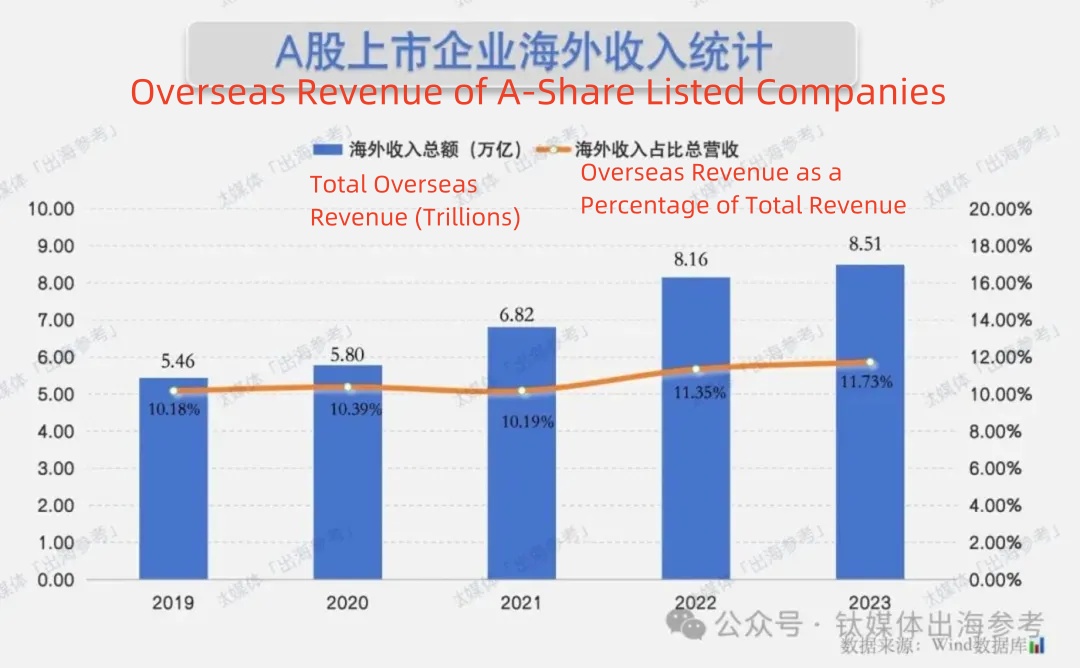Hits 8 Trillion Overseas Revenue In 2023, How Did Chinese Enterprises Make It?
Since 2023, “Going Overseas” has undoubtedly been among Chinese companies’ most critical hot topics, especially for the listed companies. Therefore, after major listed companies have successively released their annual financial reports, TMT Post reviews their overseas revenue, revenue growth rate, and other related data as important research indicators to launch this research report.
Searching for growth: an overview of Chinese companies’ overseas expansion
As of May 10, according to the statistics of 5,364 A-share companies that released their 2023 annual reports (including enterprise performance reports), 3,564 listed companies have disclosed their overseas business revenue and the proportion of companies disclosing overseas revenue was 66.44%, reaching a historical high. Hence, going overseas has become a trend and even a consensus for listed companies to seek growth. Indeed, the total overseas revenue of Chinese A-share listed companies continued to rise over the past five years. According to the published 2023 annual report data, the total overseas revenue of China’s A-share listed companies in 2023 was 8.51 trillion Yuan, an increase of more than 350 billion Yuan compared with the total overseas revenue in 2022. Simultaneously, the proportion of overseas revenue of Chinese A-share listed companies in total revenue has also shown an upward trend in the past four years, increasing from 10.18% in 2019 to 11.73% in 2023.

To comprehensively observe the overseas development of Chinese listed companies, TMT Post sorts out the financial data of Chinese companies that have announced their 2023 annual reports in the three principal trading sectors: A-shares, Hong Kong stocks, and US stocks. Based on the three quantifiable indicators (the overall revenue and its growth rate of the fiscal year 2023, the overseas revenue and its growth rate of the fiscal year 2023, and the share of overseas revenue in the fiscal year 2023), we come up with a detailed analysis of the performances of Chinese enterprises from five typical industries that are known for overseas expansion of business : medical devices, games, New Energy, home appliances, and cross-border e-commerce.
Medical devices: acceleration of overseas expansion to seek further growth.
The biopharmaceutical industry has always been the main force of Chinese enterprises in expanding overseas markets, and medical device companies are also the new forces in promoting overseas development. Nevertheless, the growth of the medical device industry in 2023 is rather unpromising. According to the “Choice” data, the overall operation revenue of 124 medical device companies in 2023 was 234.697 billion Yuan, which has decreased by 26.68% (320.116 billion Yuan in the year 2022). This slump is associated with the normalized domestic purchasing in China. However, corporations that are still maintaining a positive growth rate of overall revenue in the financial reports are the ones whose overseas revenue and the proportion of overseas revenue are simultaneously increasing.
In addition, the overseas development of medical devices displays a condition of “one superpower with many significant powers.”
As a typical enterprise with global operations, Mindray has maintained its leading position in medical device exports for multiple years. In 2023, Mindray’s overseas revenue reached a new historical record of 13.55 billion Yuan, and Mindray’s overseas revenue has long accounted for about 40% of its overall revenue. Mindray is a typical Chinese enterprise that “seeks progress while maintaining stability” in its overseas expansion. It began to expand overseas in the 1990s. Through M&As (mergers and acquisitions) and distribution channel expansions, it successfully established and improved its product line and regional coverage in overseas markets. Now, its products cover IVD, medical monitoring, high-end ultrasound, endoscopy, orthopedics, and other related machines. It operates its business in a total of 40 countries in North America, Europe, Asia, Africa, Latin America, and other regions in the world. After experiencing the high-cost-effective replacement stage, Mindray entered the high-end development stage in 2022. After the high-end process starts, Mindray’s overseas revenue and profit performances will further increase.

Since its overseas expansion in 2013, United Imaging Healthcare, another global-operating medical device enterprise, has also become a model for developing overseas markets through technological innovation. In the market of medical imaging equipment dominated by the three giants, Siemens, Philips, and GE, United Imaging Healthcare continues to build patent barriers and independently develops a series of world-leading high-end products, such as 5T MRI, 75 cm large-aperture MRI Omega, and 2-meter PET-CT. With more than 6,500 invention patents, United Imaging Healthcare leads in the growth rate of the overseas market.
However, as medical device companies are accelerating their overseas expansions, they must be aware of the potential risks of overseas markets.
On April 15, 2024, the European Union announced that it planned to launch its first investigation on Chinese medical device procurement under the guidance of the International Procurement Instrument (IPI), which made it more difficult for Chinese medical device enterprises to participate in EU bidding. As policy risks in Europe and the United States continue to escalate, the potential risks for Chinese medical device companies seeking growth overseas in 2024 are simultaneously emerging.
Games: In overseas market competition, the “easy wins” era is over.
After experiencing rapid growth from 2020 to 2022, Chinese self-developed games embraced a large amount of growth pressure in the overseas market in 2023. Both revenue and profit growth rates are decreasing. According to Gamma Data, the total revenue of Chinese games in overseas markets in 2023 decreased by 5.65%. The revenue diminished for the second consecutive year, and was on a larger scale than the previous year.
The descending revenue is consistent with the trend of the overseas game market. Affected by the uncertainty of the global economy and the reduction in online consumption of individuals after the pandemic, the growth rate of the global game market has slowed down. Sensor Tower data displays that in 2023, the consumption of overseas mobile game players decreased by 2.7% in the App Store and Google Play, with a total expenditure of 61.6 billion US dollars.
Comparing the declining data, the decline in overseas revenue of Chinese self-developed games is significantly higher than the decline in game spending by overall overseas game players.
Among all Chinese game enterprises that have developed overseas markets, the “two superpowers” remained competitive. Tencent and NetEase’s game business revenues reached 179.9 billion Yuan and 81.6 billion Yuan, with year-on-year growth rates of 5.3% and 9.43%, respectively. However, there is still a massive gap in overseas revenue between the two giants in the Chinese game industry.
In 2023, Tencent’s overseas game revenue increased by 13.7% year-on-year, accounting for nearly 30% of its total overseas revenue. NetEase’s financial report should have disclosed relevant data on overseas game revenue. However, public information on the Internet reflects that the growth rate of NetEase’s overseas game revenue has stagnated, and the proportion of overseas game revenue in 2023 is likely to be less than 10%.
Sanqi Interactive Entertainment recorded an annual revenue of 16.547 billion yuan in 2023, with an overseas revenue of 5.807 billion Yuan. Regarding the absolute amount of overall revenue, it is the game developer with the highest overseas revenue outside the “two supers.” However, overseas revenue has slightly decreased compared to 5.994 billion Yuan in 2022.
As one of the leading companies in SLG (Simulation Games) going overseas, Shell Games, a subsidiary of Shenzhou Taiyue, still maintains a strong vitality in its first products. The two main products, “Age of Origins” and “War and Order,” have generated revenue after many years of launch, mainly promoting Shenzhou Taiyue’s annual total revenue and overseas revenue. According to the financial report, Shenzhou Taiyue’s overseas revenue 2023 was 4.348 billion Yuan, an increase of 31.29% from the previous year.

These medium—and high-potential growth-oriented gaming companies will constitute the new forces in overseas market competition in the fiscal year 2024. Overall, the incremental market for overseas game exports is gradually reaching its peak, and the overseas market is also facing issues like high purchasing costs and intensified competition. Conclusively, overseas exports of Chinese games will move from an era of rapid growth to a stage of high-quality, refined, and long-term development.
New Energy: The rise of the energy storage industry in the overseas market
In 2023, the total export of China’s “Big Three” New Energy products (New Energy Vehicles, lithium-ion batteries, and photovoltaic products) exceeded the trillion Yuan mark for the first time, an increase of 29.9% year-on-year. However, there are also hidden problems behind the high-speed growth data. The power battery and photovoltaic industries have entered the structural overcapacity stage, and their growth rate has decelerated. Some markets have even involved in a “price war.” However, enterprises have predicted that there will be an increase in the global energy storage demand and overseas revenue. Hence, developing the international energy storage business has become the second goal for several New Energy listed companies seeking “increased revenue and profits.” According to relevant statistics, among the listed companies that have released their 2023 annual reports, more than 30 New Energy corporations that disclosed overseas revenue data introduced their plan of developing energy storage business (excluding portable energy storage) in their financial reports.
Among them are leading power battery and New Energy Vehicle firms, such as CATL and BYD, platform companies such as Yiwei Lithium Energy that simultaneously deploy consumer batteries, power batteries, and energy storage batteries, leading companies in the power transmission and transformation industry such as TBEA, and photovoltaic leaders such as GCL Integration that rely on the transformation of upstream photovoltaic businesses to deploy energy storage.
In 2021, CATL began independently publishing its energy storage business revenue in its annual report. The 2021 Financial report illustrated that energy storage accounted for more than 10% of the total revenue. Since then, CATL’s energy storage business has proliferated. In 2023, the company’s energy storage revenue climbed to 60 billion Yuan, and the overseas revenue growth rate has exceeded 70% in absolute and relative terms.
 Vice President of CATL, Tan Li Bin, signed the multi-year battery energy storage supply agreement with Kelcy Pegler, CEO of FlexGen in September, 2022.
Vice President of CATL, Tan Li Bin, signed the multi-year battery energy storage supply agreement with Kelcy Pegler, CEO of FlexGen in September, 2022.
The EV giant BYD did not independently present the energy storage business data in its financial statements. However, according to BYD’s public statements, BYD has the most significant number of industrial and commercial energy storage systems shipments in China in 2023. At the same time, BYD global energy storage battery shipments reached 28.4 GWh, and cumulative shipments reached 40.4 GWh.
At the end of 2023, Shenzhen Pingshan Fudi Battery Co., Ltd. was renamed Shenzhen BYD Energy Storage Co., Ltd., and the independent development path of BYD’s energy storage segment became increasingly apparent. Although overseas energy storage has become an opportunity to seek growth for many listed New Energy enterprises, market competition is highly intensive. Under the escalating competition in the energy storage industry, overseas energy storage will enter the “new and old capacity replacement” stage. The domestic energy storage price war will also diffuse to the overseas market, and profitability will become the lifeline for enterprises that runs overseas energy storage business in the future.
Home appliances: Chinese brands are making a figure in the overseas market
Home appliance companies are the “vanguards” of Chinese companies going overseas. Brands like Hisense, Haier, Midea, and TCL began exploring and developing overseas businesses 20 years ago. They have gained a foothold in the global home appliance market through mergers and acquisitions. According to data from the General Administration of Customs, the cumulative exports of Chinese household appliances in 2023 amounted to 617.42 billion Yuan, a year-on-year increase of 9.9%. As Chinese home appliance brands continue to strengthen core technologies like 5G, artificial intelligence, and the Internet, accompanied by the increasing global consumer demand for quality of life, the export of Chinese home appliances goods also are becoming more and more high-end and intelligent.
Take TCL Electronics as an example. By carrying out the “mid-to-high-end + large screen” strategy in overseas sales, TCL Electronics’ export of TCL smart screens had a year-on-year increase of 10.0% in 2023. Among the smart screens that were exported, the overseas export of smart screens of 65 inches and above increased by 60.3% year-on-year, which drove the TCL smart screen market revenue to increase by 8.7% compared with 2022.

Hence, it is easy to perceive that the overall and overseas revenue of the old leading home appliance brands have increased significantly. Nevertheless, some emerging home appliance brands specializing in developing smart cleaning products have also performed well in overseas markets; The Midea Group’s overall performance in 2023 demonstrates that its smart home products, primarily HVAC and consumer appliances, still comprise a big part of its overall revenue, reaching 295.8 billion Yuan. Besides, Midea’s overseas revenue accounts for 40.56% of total revenue in 2023.
Midea’s overseas business started by becoming the OEM (Original Equipment Manufacturer) for international brands, serving international home appliance giants such as GE, Panasonic, and Toshiba. In 2006, Midea began promoting self-owned brands in the overseas market through mergers and acquisitions and building factories abroad. 2016, Midea Group acquired Toshiba’s white household appliance business to strengthen its global high-end product promotion.
The overseas mergers and acquisitions by another emerging home appliance brand, Haier, are even more frequent than Midea. Since 2011, Haier has acquired Sanyo Electric from Japan, Fisher & Paykel from New Zealand, GEA from the US, Candy from Italy, and other overseas enterprises. In 2023, Haier’s overseas revenue growth rate reached 7.62%, with overseas revenue accounting for more than 50% of the total revenue. In addition, revenue from the European and American markets accounted for nearly 80% of all overseas revenue, and the growth rate is significant.
According to Euromonitor forecasts, the retail market size of global home appliance products (including core and small appliances) will reach 540.6 billion US dollars by the end of 2024. The retail sales of core home appliances will reach 292.5 billion US dollars, which increases by 1.9% year-on-year. Retail sales of small household appliances reached $248.2 billion, which increased by 2.1% year-on-year. Hence, the overseas market is vital for smart home appliance brands seeking revenue growth.
Cross-border e-commerce: Upgrading amid prosperity.
According to data from the General Administration of Customs, China’s cross-border e-commerce imports and exports reached 2.38 trillion yuan in 2023, an increase of 15.6%. The export value reached 1.83 trillion yuan, an increase of 19.6%, and imports were 548.3 billion yuan, an increase of 3.9%. The proportion of cross-border e-commerce in China’s total import and export of goods has increased from 1% in 2015 to 5.7% in 2023. As the proportion of cross-border e-commerce in foreign trade continues to rise, the cross-border e-commerce industry will experience a long-term growth period. The 2023 financial report articulated that the total revenue of global e-commerce platforms (Amazon and eBay) had increased by 11.83% and 4.15% year-on-year. An explosion of profits always accompanies steady revenue growth. In 2023, the net profits of Amazon and eBay increased by 1217.74% and 317.82% year-on-year.
Simultaneously, the growth momentum of Chinese cross-border e-commerce platforms is also worth discussing.
The latest quarterly financial report released by Alibaba Group in February showed that Alibaba International Digital Business Group’s revenue increased by 44% year-on-year, reaching 28.616 billion Yuan. AliExpress even achieved an increase of over 60%. Although Pinduoduo, another large global e-commerce platform in China, did not independently disclose the revenue data of its cross-border platform Temu in its financial report, it is speculated that the “transaction service business” in Pinduoduo’s fourth-quarter financial report last year, which revenue reached 40.21 billion Yuan with a year-on-year increase of 357%, was most likely facilitated by Temu.

The other two cross-border platforms, Shein and TikTok Shop, still need to be listed, and their public data is not available either. According to speculation by several market institutions, Shein’s GMV (Gross Merchandise Volume) in 2023 will reach approximately 45 billion US dollars, with a profit of more than 2 billion US dollars; TikTok Shop’s GMV in Southeast Asia alone in 2023 would be approximately 11.86 billion US dollars, and its goal in 2024 is to achieve a GMV of 50 billion US dollars. TMT Post also found through statistics of various financial reports that nearly half of the companies mentioned above are optimizing their supply chains by building their overseas warehouses to reduce costs and improve efficiency.
In conclusion, Overseas revenue is only one of the evaluation dimensions of enterprises going overseas. The global operation itself is a complex system. To truly become a global brand, there are other relevant indicators besides revenue that need to be further studied and evaluated.




